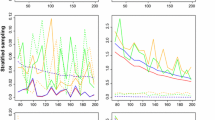Summary
We describe a new method for asking questions involving recall in surveys, called Respondent-Generated Intervals (RGI). We ask respondents for lower and upper bounds for the true answer to a factual question, as well as their best guess. For example, “How many times did you visit your doctor last year?” Also, “What is the largest value the true value is likely to be, and what is the smallest value the true value is likely to be?” Bayesian and other estimators are proposed. We describe several empirical studies that have used, and are using the RGI protocol.
Access this chapter
Tax calculation will be finalised at checkout
Purchases are for personal use only
Preview
Unable to display preview. Download preview PDF.
Similar content being viewed by others
References
Evans M, Swartz T (1995). Methods for Approximating Integrals in Statistics With Special Emphasis on Bayesian Integration Problems, Statistical Science, Vol. 10, No. 3, pp. 254–272.
Heeringa SG, Hill, DH, Howell, DA (1995). Unfolding Brackets for Reducing Item Non-Response in Economic Surveys, Health and Retirement Study Working Paper Series, Paper No. 94–029, Institute for Social Research, University of Michigan, June, 1995.
Hogarth R (1980). Judgment and Choice: The Psychology of Decision, New York: John Wiley and Sons, Inc.
Kennickell AB (1997). Using Range Techniques with CAPI in the 1995 Survey of 80 S. James Press and Judith M. Tanur Consumer Finances, Jan., 1997, Board of Governors of the Federal Reserve System, Washington, D.C. 20551.
Kish L (1965) Survey Sampling. New York: John Wiley and Sons.
Marquis KH, Press SJ (1999). Cognitive Design and Bayesian Modeling of a Census Survey of Income Recall, Proceedings of the Federal Committee on Statistical Methodology Conference, Washington, DC, Nov. 16, 1999, pp.51–64 (see http://www.bts.gov/fcsm ).
Press SJ (1989). Bayesian Statistics: Principles, Models and Applications, New York: John Wiley and Sons, Inc.
Press SJ (1999). Respondent-Generated Intervals for Recall in Sample Surveys, manuscript, Department of Statistics, University of California, Riverside, CA 92521–0138, Jan., 1999. http://www.cnas.ucr.edu/-.stat/press.htm.
Press SJ (2002). “Respondent-Generated Intervals For Recall in Sample Surveys”, Technical Report No. 272, July, 2002, Department of Statistics, University of California, Riverside.
Press SJ, Marquis KH (2001) Bayesian Estimation in a U. S. Census Bureau Survey of Income Recall Using Respondent-Generated Intervals. Journal of Research in Official Statistics, Amsterdam: Eurostat.
Press SJ, Marquis KH (2002) Bayesian Estimation in a U.S. Government Survey of Income Using Respondent-Generated Intervals. Proceedings of the Sixth World Meeting of the International Society for Bayesian Analysis, May, 2000, Crete, Greece; Amsterdam: Eurostat.
Press SJ, Tanur JM (2000) Experimenting with Respondent-Generated Intervals in Sample Surveys, with discussion. Pages 1–18 in Monroe G. Sirken (ed.) Survey Research at the Intersection of Statistics and Cognitive Psychology, Working Paper Series #28, National Center for Health Statistics, U.S. Department of Health and Human Services, Center for Disease Control and Prevention.
Press SJ, Tanur JM (2001). Respondent-Generated Interval Estimation to Reduce Item Nonresponse, in Applied Statistical Science V,Nova Science Publishers, pp. 39–49, M. Ahsanullah, J. Kennyon, S.K. Sarkar (Eds.). See also, http://cnas.ucr.edu/—stat/press.htm
Press SJ, Tanur JM (2002). “Cognitive and Econometric Aspects of Responses to Surveys as Decision-Making”, Technical Report No. 271, June, 2002, Department of Statistics, University of California, Riverside.
Schlaifer H (1959). Probability and Statistics for Business Decisions, New York: McGraw-Hill Book Co., Inc.
Author information
Authors and Affiliations
Editor information
Rights and permissions
Copyright information
© 2003 Springer Japan
About this paper
Cite this paper
Press, S.J., Tanur, J.M. (2003). The Respondent-Generated Intervals Approach to Sample Surveys: From Theory to Experiment. In: Yanai, H., Okada, A., Shigemasu, K., Kano, Y., Meulman, J.J. (eds) New Developments in Psychometrics. Springer, Tokyo. https://doi.org/10.1007/978-4-431-66996-8_6
Download citation
DOI: https://doi.org/10.1007/978-4-431-66996-8_6
Publisher Name: Springer, Tokyo
Print ISBN: 978-4-431-66998-2
Online ISBN: 978-4-431-66996-8
eBook Packages: Springer Book Archive




